Michelle Paver's Blog, page 44
May 3, 2016
Thin Air
Kangchenjunga.
Third-highest peak on earth.
Greatest killer of them all.
Five Englishmen set off from Darjeeling, determined to conquer the sacred summit. But courage can only take them so far – and the mountain is not their only foe.
As the wind dies, the dread grows.
Mountain sickness.
The horrors of extreme altitude.
A past that will not stay buried.
And sometimes… the truth does not set you free.
So Where, Exactly, Does Torak Live?
The one question every reader of Chronicles of Ancient Darkness wants answered is this – where are the stories set? Are they in a REAL PLACE that actually exists? And if so, where IS it?
In this new video, Michelle finally gives the answers…
April 12, 2016
The Test Post Title

Michelle Paver, yesterday. What happens if this is quite a long caption? Let’s find out now.
Michelle was born in Nyasaland (now Malawi), where her South African father ran the tiny Nyasaland Times, and her Belgian mother wrote a weekly gossip column. But the days of genteel colonial society were numbered, and in 1963 the family moved to England, where she was educated in Wimbledon and at Lady Margaret Hall, Oxford.
There she read Biochemistry and also made her first serious attempts at writing: two Mills & Boon-type novels, written in a matter of weeks and summarily rejected (‘with good reason!’ she says), followed by a couple of children’s fantasy novels – also rejected, although more encouragingly.
By then she was in the grip of the writing bug. She even managed to ditch the usual final-year laboratory project in favour of a written thesis: simply because, as she admits, ‘I’d stumbled on a great story: Soviet genetics driven underground by an illiterate crony of Stalin’s. How could I resist?’
“I knew I wanted to write, but I didn’t think I’d be able to make a living at it…”That got her a First, but by then she’d decided against a career in science. ‘I knew I wanted to write, but I didn’t think I’d be able to make a living at it, so I looked around for a day job: something that would pay the bills while giving me time to write. Like an idiot, I chose the Law. It was a spur-of-the-moment decision. One rainy afternoon I was leafing through a careers brochure when I came across an article on being a solicitor. I thought, ‘that’ll give me a few years’ breathing space before it gets too demanding, so why not?’’
Of course it didn’t turn out quite like that. Michelle qualified as a solicitor with a big City firm, and was soon up to her neck in big-ticket scientific litigation. Multinational drug companies slugging it out over who owned which gene; tobacco companies battling to defend themselves against plaintiffs dying of cancer. ‘There were times,’ she says, ‘when I didn’t exactly feel on the side of the angels.’
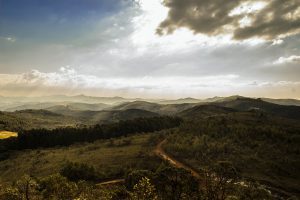


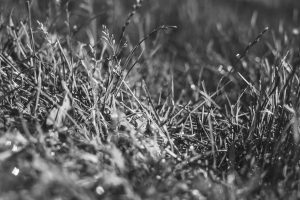
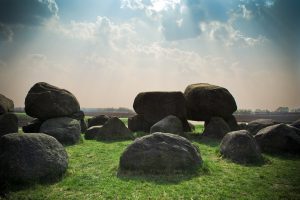
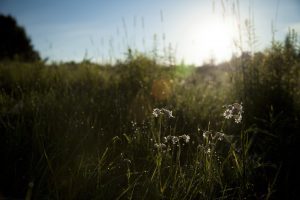
Outwardly she was a success, having been made a partner five years after qualification. But the strain of all-night meetings and missed weekends was beginning to tell. Then in 1996 her father died, and that proved a wake-up call.
‘I realized that I wasn’t doing what I really wanted to do, and although I was earning lots of money, I’d never have time to spend it. So I decided to negotiate a year off, to get myself sorted out. At the time, that was unheard-of in a City firm. They didn’t even have a sabbatical policy. But I told myself that if they said no, I’d quit anyway, and that at least gave me the courage to ask. To my astonishment, they said yes.’
Michelle spent 1997 travelling around Peru, Ecuador, South Africa, France, and the States, and finishing the first draft of Without Charity…
“It’s no coincidence that the story is all about seizing the moment…”‘It’s no coincidence that the story is all about seizing the moment. And it’s also personal in another way, as it’s partly set during the Boer War, which bankrupted my father’s family. Although they were fiercely loyal to the Crown, they fell victim to the scorched earth policy when the British burnt most of their farms – by mistake!
To my surprise, researching the book in South Africa turned out to be a pretty emotional experience. I kept wishing my father could have been with me. For example, when I visited the little farming town of Reitz, where the early Pavers settled in the nineteenth century, I found a portrait of my great-grandfather, the second mayor, hanging in the Town Hall, and even a ‘Paver Straat’.’
https://vimeo.com/72091242
I am a video caption
After her year off Michelle returned to the City, and realized on the very first day that it was a mistake…
‘There were three thousand e-mails clogging up my computer, and all I could think about was Without Charity. So I sent the manuscript off to a publisher, and then, without waiting for a reply, I resigned. A couple of months later, I was offered a publishing contract – to my relief!’
Without Charity was selected by WH Smith (Britain’s biggest booksellers) as one of a handful of debut novels to be awarded their Fresh Talent accolade. Since then, Michelle has worked as a writer full-time.
“I was trying to prove to myself that true, self-sacrificing, altruistic love can actually exist….”Michelle’s second book, A Place In The Hills, tells two intertwined love stories that take place two thousand years apart…
‘I’ve always been passionate about ancient Rome, and I’ve always loved the idea of a contemporary character having a real connection with someone in the distant past. But why a love story? Well, in a way, I was trying to prove to myself that great love – true, self-sacrificing, altruistic love – can actually exist. To my surprise, I ended up convincing myself. Although what the reader will think about that is up to them.’
A Place In The Hills was short listed for the 2002 Parker Pen Romantic Novel of the Year award. Her third book, The Shadow Catcher, was the first in the EDEN trilogy.
‘It’s set in colonial Jamaica,’ she says, ‘at a crucial period of transition: the slaves had been freed, the great sugar plantations were in decay, and there was an incredible sense of uncertainty. The tone of the story is what I’d call Caribbean Gothic. With my background I’m obviously drawn to themes of the Empire under threat, but the EDEN trilogy is as much about class, and the position of women in Victorian society.’
‘Researching it was an experience in itself. In Jamaica, everyone seems to know everyone else, so if you’ve got family there, as I have (this time on my mother’s side), you’re instantly connected to what seems like half the population. For example, my cousin has a farm on the north coast, and his wife’s friend’s mother is a leading light in the Jamaica Historical Society, and she’s married to the grandson of a Victorian vicar who just happened to write the seminal work on Jamaican magic back in the 1890s, and so it goes on…’
“The old enthusiasms hadn’t gone away; they’d just broadened and taken root”In 2003, Michelle started work on an idea for a series of six books that had been brewing ever since childhood. Set in prehistoric, hunter/gatherer times, in a world of dark enchantment, menace and superstition, the stories revolve around a boy – and his wolf companion – growing up, fighting for survival and unleashing a powerful magic…
‘Chronicles Of Ancient Darkness is my way of achieving what I used to dream about when I was ten years old: to run with the wild wolves in the prehistoric Forest.
‘As a child, my passions were myths, animals, and how people actually lived in the distant past. I read and re-read Roger Lancelyn Green’s tales of the Norsemen and the Ancient Egyptians. I pored over pictures of Stone-Age hunters scraping hides and knapping flints. I bought a copy of Culpeper’s Herbal, and dug up my parents’ lawn to grow outlandish medicinal plants. And I read everything I could find on animal behaviour: especially about wolves. (Wolf researchers such as David Mech, Michael Fox and Lois Crisler quickly became my heroes.)’
‘As I grew older, I managed to do a fair bit of travelling in out-of-the-way places: Iceland, Norway, South America, the Rockies; often hiking on my own so as not to dilute the experience. I worked as a volunteer on a wildlife survey in the Carpathian Mountains, where I heard red deer bellowing in rut, and found fresh wolf-tracks calmly crossing my own, and nearly lost my nerve when I came across an enormous pile of steaming dung. (Bear? Bison? I didn’t hang around to find out.)’
‘Gradually I realised that the old enthusiasms hadn’t gone away; they’d just broadened and taken root. And when I had the idea for Chronicles Of Ancient Darkness, it all came together…’
March 16, 2016
Ghosts In The High Arctic
About a decade ago, I was reading a book on cosmology when the term “dark matter” leapt out at me. I knew at once that this would be my story’s title.
I knew at once this would be my story’s titleI also knew that it would be about a scientist at an isolated research station, who discovers that it’s haunted. But this was all I knew. I had no idea where the haunting would take place, or how it would end.
A few years after that, I was traveling by ship around Spitsbergen (or Svalbard, to give it its official name) : the icy group of islands far to the north of Norway, and only a few hundred miles from the North Pole.
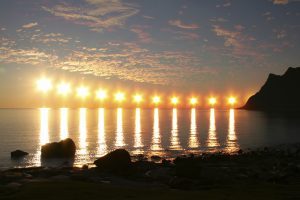
North of the Arctic Circle or south of the Antarctic Circle, the sun is visible for the full 24 hours around the summer solstice
It was summer, the time of the midnight sun. In that endless, eerie daylight, we explored lonely bays dotted with icebergs, and desolate promontories strewn with the giant ribs of whales. There was life up here – seabirds, seals, walruses, polar bears -but behind it I sensed a peculiar, unnerving stillness. Perhaps it was the presence of the land itself. Or the winter darkness waiting to return.
I was sure that one day, I’d write about this. But at the time, I was deep in my series about wolves and the Stone Age, so I just took lots of notes, and pushed Spitsbergen to the back of my mind.
Ghosts are stronger in the darkA couple of winters later, I fell again to thinking about ghosts, as I often do during the dark months. That year in London there was hardly any snow, and I was badly missing the Arctic. That’s when it hit me. DARK MATTER would be a polar ghost story.
The implications were clear at once, and immediately frightening. Ghosts are stronger in the dark. They’re less threatening by day. But what if you were in the Arctic? What if you found yourself alone, in the deep of the polar night, and dawn was four months away?
The skeleton of the story came swiftly once I had that pivotal idea. It would take place in 1937. As war looms in Europe, a lonely young man called Jack seizes the chance to change his life, and volunteers to be the wireless operator on an Arctic expedition. Five men and eight huskies will camp for a year on an uninhabited bay on the remote north coast of Spitsbergen.
At first, all goes well. But as the midnight sun gives way to autumn, and then to the endless dark of the polar night, a series of mishaps means that Jack finds himself manning the base camp alone. And by now he has discovered that this isolated bay is not uninhabited. Something walks there, on the black beach among the bones…
My aim in writing DARK MATTER was simple: to scare the hell out of the reader. To do that, I knew it would be crucial to make the expedition feel absolutely real. Everything about it must be so convincing that the reader would think, “This could be me”. Then the haunting would be real, too.
Some of it I couldn’t possibly have made upThat’s why I based the expedition on one which actually took place, in 1935-6. Much of the day-to-day detail – what they wore, what they ate, how they built their cabin and got on with their huskies – is based on the reports of this expedition. In fact, some of it I couldn’t possibly have made up. Who would have imagined that a group of twenty-something Oxbridge graduates would journey to the Arctic with a set of Crown Derby china, a gramophone, and several bottles of 1926 Heidsick Champagne?
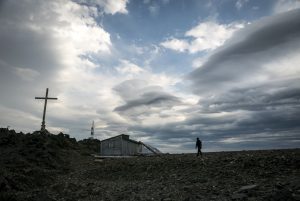 Those doughty expeditioners weren’t the only ones to have overwintered on Spitsbergen in the 1930s. From the diaries of trappers who stuck it out for months in cramped cabins utterly cut off from the outside world, I’ve learned what it can do to a man (or woman) to suffer the loneliness and the ever-present threat of danger; to endure the extremes of the High Arctic: perpetual daylight in summer, perpetual darkness in winter.
Those doughty expeditioners weren’t the only ones to have overwintered on Spitsbergen in the 1930s. From the diaries of trappers who stuck it out for months in cramped cabins utterly cut off from the outside world, I’ve learned what it can do to a man (or woman) to suffer the loneliness and the ever-present threat of danger; to endure the extremes of the High Arctic: perpetual daylight in summer, perpetual darkness in winter.
But the accounts of others can only ever take you so far.
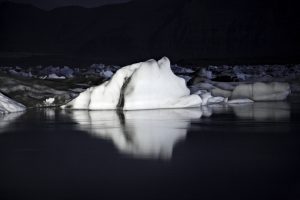 To make DARK MATTER truly come alive, I went back to Spitsbergen in winter, and experienced the polar night for myself. I went husky-sledging in the dark at ten degrees below zero, and snow-shoed up a glacier with only a headlamp to light my way. I felt the unease you experience on first entering a tiny, freezing, unlit cabin; unease which doesn’t entirely go away even when you’ve got your paraffin lamp safely lit. Because you can’t help wondering what’s outside, just beyond the reach of the light.
To make DARK MATTER truly come alive, I went back to Spitsbergen in winter, and experienced the polar night for myself. I went husky-sledging in the dark at ten degrees below zero, and snow-shoed up a glacier with only a headlamp to light my way. I felt the unease you experience on first entering a tiny, freezing, unlit cabin; unease which doesn’t entirely go away even when you’ve got your paraffin lamp safely lit. Because you can’t help wondering what’s outside, just beyond the reach of the light.
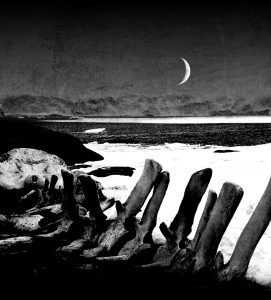 What’s looking in at you from the dark?
What’s looking in at you from the dark?
Above all, I experienced what it’s like to go crunching through the snow when there’s no moon and you haven’t got a torch; when the echoing scrape of your snowshoes can sound as if there were someone following you close behind. And when that dim grey shape which you can just make out a few paces away might be a reindeer, or a husky, or a polar bear.
Or something worse.
Ghosts In The High Arctic: The Writing Of Dark Matter
For years I’d wanted to write a ghost story, but I’d never come up with an idea which really had teeth. Then about a decade ago I was reading a book on cosmology when the term “dark matter” leapt out at me. I knew at once that this would be my story’s title. I also knew that it would be about a scientist at an isolated research station, who discovers that it’s haunted. But this was all I knew. I had no idea where the haunting would take place, or how it would end.
A few years after that, I was traveling by ship around Spitsbergen (or Svalbard, to give it its official name) : the icy group of islands far to the north of Norway, and only a few hundred miles from the North Pole.
It was summer, the time of the midnight sun. In that endless, eerie daylight, we explored lonely bays dotted with icebergs, and desolate promontories strewn with the giant ribs of whales. There was life up here – seabirds, seals, walruses, polar bears -but behind it I sensed a peculiar, unnerving stillness. Perhaps it was the presence of the land itself. Or the winter darkness waiting to return.
I was sure that one day, I’d write about this. But at the time, I was deep in my series about wolves and the Stone Age, so I just took lots of notes, and pushed Spitsbergen to the back of my mind.
A couple of winters later, I fell again to thinking about ghosts, as I often do during the dark months. That year in London there was hardly any snow, and I was badly missing the Arctic. That’s when it hit me. DARK MATTER would be a polar ghost story.
The implications were clear at once, and immediately frightening. Ghosts are stronger in the dark. They’re less threatening by day. But what if you were in the Arctic? What if you found yourself alone, in the deep of the polar night, and dawn was four months away?
The skeleton of the story came swiftly once I had that pivotal idea. It would take place in 1937. As war looms in Europe, a lonely young man called Jack seizes the chance to change his life, and volunteers to be the wireless operator on an Arctic expedition. Five men and eight huskies will camp for a year on an uninhabited bay on the remote north coast of Spitsbergen. At first, all goes well. But as the midnight sun gives way to autumn, and then to the endless dark of the polar night, a series of mishaps means that Jack finds himself manning the base camp alone. And by now he has discovered that this isolated bay is not uninhabited. Something walks there, on the black beach among the bones…
My aim in writing DARK MATTER was simple: to scare the hell out of the reader. To do that, I knew it would be crucial to make the expedition feel absolutely real. Everything about it must be so convincing that the reader would think, “This could be me”. Then the haunting would be real, too.
That’s why I based the expedition on one which actually took place, in 1935-6. Much of the day-to-day detail – what they wore, what they ate, how they built their cabin and got on with their huskies – is based on the reports of this expedition. In fact, some of it I couldn’t possibly have made up. Who would have imagined that a group of twenty-something Oxbridge graduates would journey to the Arctic with a set of Crown Derby china, a gramophone, and several bottles of 1926 Heidsick Champagne?
Those doughty expeditioners weren’t the only ones to have overwintered on Spitsbergen in the 1930s. From the diaries of trappers who stuck it out for months in cramped cabins utterly cut off from the outside world, I’ve learned what it can do to a man (or woman) to suffer the loneliness and the ever-present threat of danger; to endure the extremes of the High Arctic: perpetual daylight in summer, perpetual darkness in winter.
But the accounts of others can only ever take you so far. To make DARK MATTER truly come alive, I went back to Spitsbergen in winter, and experienced the polar night for myself. I went husky-sledging in the dark at ten degrees below zero, and snow-shoed up a glacier with only a headlamp to light my way. I felt the unease you experience on first entering a tiny, freezing, unlit cabin; unease which doesn’t entirely go away even when you’ve got your paraffin lamp safely lit. Because you can’t help wondering what’s outside, just beyond the reach of the light. What’s looking in at you from the dark?
Above all, I experienced what it’s like to go crunching through the snow when there’s no moon and you haven’t got a torch; when the echoing scrape of your snowshoes can sound as if there were someone following you close behind. And when that dim grey shape which you can just make out a few paces away might be a reindeer, or a husky, or a polar bear.
Or something worse.
November 9, 2015
The Crocodile Tomb
A country at the edge of the world.
A hidden tomb.
A buried secret.
Hylas and Pirra have found their way to the mysterious land of Egypt in pursuit of the dagger of Koronos, only to find that the Crows have got there first. Led by Hylas’ deadly enemy, Telamon, they are determined to recover the legendary blade, by any means necessary.
But the dagger now lies buried beyond the reach of mortals. If Hylas and Pirra want it back, they will have to make the most dangerous journey of all – into the realms of death itself…
The Crocodile Tomb is the fourth book in Michelle’s Gods & Warriors series.
The Eye of the Falcon
An endless winter.
A plague-haunted land.
A dying people.
Winter has been colder than anyone can remember – and there is no spring. The terrible eruption of Thalakrea has shrouded the sky in ash and blocked the Sun.
The winds of Fate bring Hylas to the island of Keftiu. He is desperate to find his friends: Pirra the daughter of the High Priestess and Havoc the lion cub. But Keftiu has suffered more than anywhere from the fury of the gods, and the once-prosperous island has been ravaged by cold, famine and plague.
The Eye of the Falcon is the third book in Michelle’s Gods & Warriors series.
The Burning Shadow
A boy on the run.
A deadly prophecy.
A race against time.
Hylas the Outsider is captured by slavers. Set to work in the terrible underground mines of Thalakrea, he learns to his horror that he’s now closer than ever to his murderous enemies, the Crows. He has to escape before they find out he’s here.
Pirra, the daughter of the High Priestess, is also on the run. When Fate reunites her with Hylas, their survival depends on ancient magic and an orphaned lion cub – unless the Gods have other plans…
The Burning Shadow is the second book in Michelle’s Gods & Warriors series.
The Outsiders
From a time of myths and ancient magic comes the legend of the lost city of Atlantis, tales of gods and warriors – and the rise of a hero…
Hylas is only a boy but he knows three things:
The gods exist.
Magic is real.
Somebody wants him dead.
Hunted and alone, Hylas is desperate to find his missing sister. His quest takes him across the hostile mountains and treacherous seas of ancient Greece. His only friend is a girl on the run. His only guide is a wild dolphin.
And his murderous enemies are closing in…
The Outsiders is the first book in Michelle’s Gods & Warriors series.
October 29, 2015
THIN AIR Goes To Orion
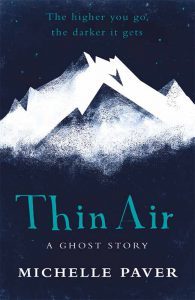 Jon Wood, Publisher of the Orion Publishing Group has acquired Michelle Paver’s ghost story THIN AIR from Peter Cox of Redhammer. Orion has secured World Rights and will publish in hardback and ebook in October this year.
Jon Wood, Publisher of the Orion Publishing Group has acquired Michelle Paver’s ghost story THIN AIR from Peter Cox of Redhammer. Orion has secured World Rights and will publish in hardback and ebook in October this year.
THIN AIR is a spine-tingling ghost story set in the Himalayas during the golden age of mountaineering.
Jon Wood said:
“DARK MATTER is one of the books I have been most proud to publish – truly dark and terrifying.
THIN AIR once again demonstrates that Michelle Paver is one of the most fluent and powerful storytellers of our time.”
Michelle Paver explained her fascination with the Himalayas:
I thought, ‘what if there’s a ghost?”“Unable to sleep one night, I came across some mountaineering books in my study, and read into the small hours. I read of the great Himalayan expeditions of the ‘20s and 30s: the fever for the summit, the loneliness of high places; the delusions and the dread. On a mountain, the tragedies of the past can feel all too present. I thought, ‘what if there’s a ghost?’
Orion did a terrific job with my first ghost story, DARK MATTER, and I’m thrilled that they’re publishing my new one. With Jon Wood leading the team, I know they have the imagination, commitment and flair to take THIN AIR to the heights.”
Michelle Paver is one of the top bestselling authors in the UK. DARK MATTER was her first adult ghost story. It was widely acclaimed, a UK Top Ten bestseller, and was a Richard & Judy Bookclub pick.
Michelle Paver's Blog
- Michelle Paver's profile
- 2302 followers



